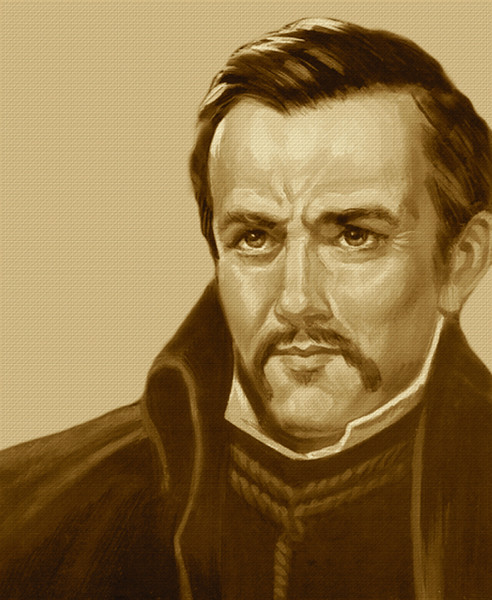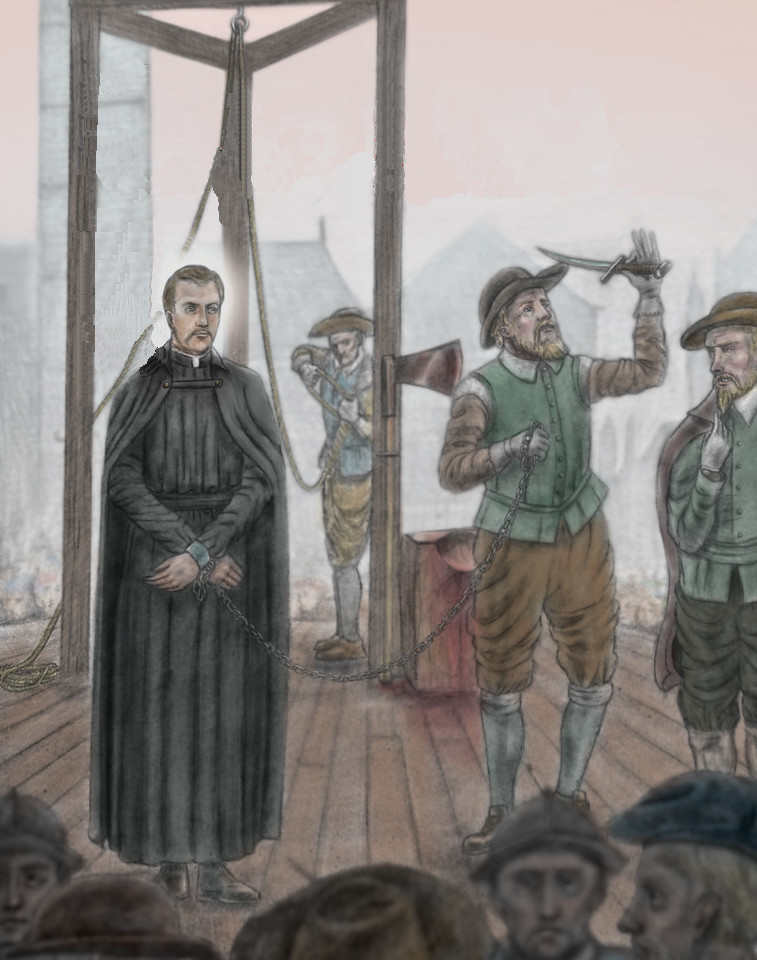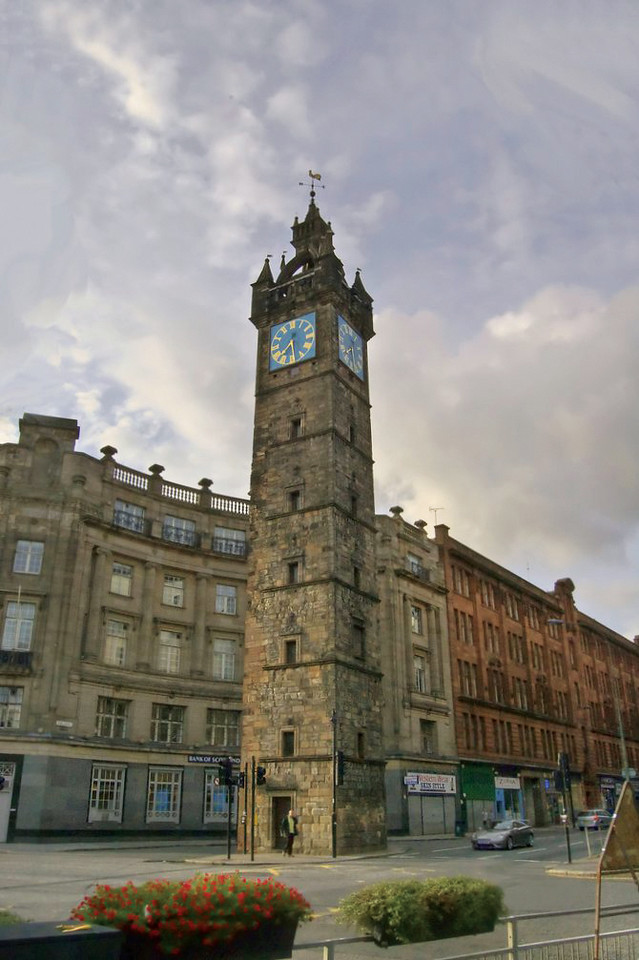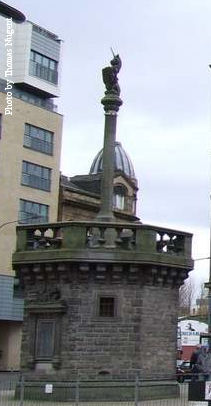
Mercat cross. The Mercat Cross stands at the south-eastern corner of Glasgow Cross, near the Tolbooth Steeple. It is a monument to St. John Ogilvie and was commissioned for construction in 1929–30 by William George Black, and designed by the architect Edith Hughes.
Betrayal
Every hero needs an antagonist, and Fr. Ogilvie had Allan Boyd, a traitorous informer. This other “Judas” told the Protestant Archbishop Spottiswoode about the “papist priest” working under his nose. Pretending that he wanted to be reconciled to the Church, Boyd arranged to meet Fr. Ogilvie in Glasgow. The trap set, Boyd and the Archbishop’s henchmen captured Fr. Ogilvie.
On being dragged into Spottiswoode’s house, Fr. Ogilvie was struck on the face by the Archbishop. Spottiswoode proclaimed: “You are overbold to say your masses in a reformed city.”
Fr. Ogilvie retorted “You are more like a hangman and not a bishop in striking me.”
This was the beginning of a calculated attempt to break down the resistance of Fr. Ogilvie, which lasted for six months: October 5, 1614 to March 10, 1615.
Interrogation followed interrogation, debate followed debate, but Fr. Ogilvie and his ever-present wit always triumphed. Spottiswoode was determined to make an example of this papist priest, and contacted King James about the matter. The king agreed that the priest should be further “examined.”
Bribery and Torture
Getting nowhere in his attempts to physically break our hero’s resolve, Spottiswoode began a more psychological approach by offering him the Provostship of Moffat. As chief magistrate of a wealthy Scottish burgh, Fr. Ogilvie would be guaranteed a good income, plus a noble wife, and gifts from the king, if only he would turn Protestant. Fr. Ogilvie refused.
The next ploy was an attempt to break his mind. Four men were assigned to enter his cell and prevent him from sleeping. Day and night they kept him awake, pinching and pricking him every time his eyes closed. By the fifth day, the points of their daggers were needed to rouse him. Doctors came, and allowed the torture to go on. When the daggers failed to rouse him, the guards would lift him to his full height, and then drop him to the ground. By the eighth day, even this failed to rouse him, so they resorted to dragging him around the floor. On the ninth night, the doctors said he wouldn’t last more than three hours. Finally he was left in peace to sleep. After only a day to recover, he was once again brought to trial. To the utter surprise of all, Fr. Ogilvie was as defiant as ever, and answered their questions boldly and intelligently.
Tried for Treason
King James had been following the case intently, and now sent a series of questions for the Jesuit to answer, all linked to the false teachings on the ”divine right of kings” which James espoused. Fr. Ogilvie, knowing that an honest reply would bring death, bravely gave answers that were in line with Church teachings. On receiving the answers, King James ordered that he be found guilty of treason, and sentenced to be hanged and quartered.
Three hours later, our Saint was led out to the gallows. Thousands crowded around the scaffold. Two ministers accompanied him. Fr. Ogilvie, taking the opportunity to play the interrogator as a way of educating the crowd gathered to watch his execution, asked the two ministers of the King in a loud and clear voice, “What did you say I could have if I change?”
Excited by what they perceived as a triumph for Protestantism, the ministers repeated the offer of the Provostship of Moffat.
“What else?” replied Fr. Ogilive, as he climbed the steps.
“A noble wife, and presents from the king,” they announced optimistically.
But having reached the top of the stairs, his feet firmly planted on the platform of the scaffold upon which he could only expect torture and death, he boldly and loudly exclaimed, “What does it profit a man if he gains the whole world, and suffers the loss of his soul?”
Taken aback and not yet willing to relinquish his prey, one of the ministers asked, “Aren’t you afraid to die?”
Looking out over the crowd and employing for one last time the wit that had served him so well, Fr. John replied, “In so good a cause I am no more afraid to die than you are of the dishes when you go to supper.”
Taking his rosary from his pocket, he threw it into the crowd. The rosary landed in the hands of Duke Jean de Eckersdorff, a Hungarian Calvinist who was touring Scotland at the time. Duke Eckersdoff later stated “abruptly the Catholics rushed upon me asking for the rosary, so that, to avoid being overwhelmed, I was obliged to throw the rosary from me.” Duke Eckersdoff later converted, saying “I ascribe my conversion to nothing other than that rosary. If I could acquire it today, I would give much gold for it, and I would not exchange it for gold.”
Saint John Ogilvie’s last words were, “If there be here any hidden Catholics, let them pray for me, but the prayers of heretics I will have none.” The hangman pushed him off the ladder, and as he swung, jumped down and, contrary to custom, tugged sharply at his legs and swiftly ended the agonies of slow strangulation.
From the crowd, there was no shouting of jubilation at the death of a traitor. The officers at the execution sensed that what had been done had shocked the onlookers deeply.
Without carrying out the brutal sentence of quartering, the hangman and his assistants placed the body in a coffin and it was buried quickly in the burial ground reserved for those who died of the plague.
Aftermath
So here we have the story of Scotland’s only canonized post-reformation Catholic martyr. But was one martyr enough for Scotland? Or was one martyr too much? Both questions could be answered in the affirmative. One was enough to reawaken Catholic sentiment in souls, and one was too much for the Protestants to cope with.
For the Protestant authorities, observing studiously the attitude of the crowd before, during and after the execution, the conclusion was worrisome.
The crowd obviously contained many, many Catholics. The story and example of Saint John Ogilvie’s courageous martyrdom would be told far and wide, and could embolden Catholics to continue to resist the new religion, or inspire others to come back to the Faith.
In truth, the Catholics weren’t afraid. No more Catholics were publicly martyred, not because there were too few of them, but because there were too many of them, and, being a martial people, the fear of an uprising against Protestantism was an all too possible reality.
Other captured priests over the next decades were either exiled or, like Fathers Ryan, Devoir and Munro, rather than facing public trial, were put into prison and left to die. Their silent martyrdom ended in dark prisons, unseen by men, but each one witnessed in heaven by God, His angels and His saints!
“The blood of the martyrs are the seeds of the Faith.” After our hero’s crown of martyrdom was secured, Catholicism was bravely and loyally protected in the Highlands. There was even a secret seminary built there where over a hundred young men were trained to be priests.
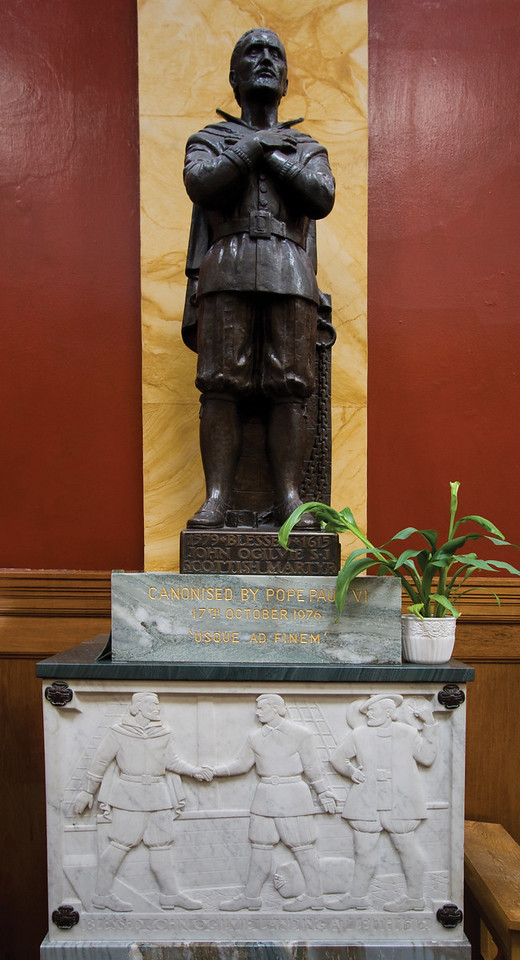
Statue of Saint John Ogilvie, Sacred Heart Church, Edinburgh. The saint used civilian clothes in order to hide his identity.
Following Saint John Ogilvie
This harrowing account of torture and martyrdom may well be too high and bloody a bar for a 21st century Catholic to want to reach. But Holy Mother Church assures us that sanctity takes many forms. It is enough to retain the noble title of “Catholic” to be like those in Ezekiel 9: 4-6: “God instructed the cherubim to pass through the city and mark a cross upon the foreheads of those who SIGH AND GROAN OVER ALL THE ABOMINATIONS that are committed in it.” That cross was to be a sign of protection against the chastisement to be dealt out by the cherubim to follow.
In this time in which we find ourselves, a time not so unlike that of the hero of our story, may the example of Saint John Ogilvie embolden us to step out of our comfort zones to defend the unborn and traditional marriage. Let us emulate his disdain for human respect and conduct ourselves in modesty, clean speech and healthy living, though we may lose the false friendships of some in so doing. May Our Blessed Lord give us the same quick wit and eloquence of speech He gave to Saint John when it comes time to speak out against blasphemy and the culture of death that at times seems to press in on every side. Though our modern martyrdom be unbloody, it is no less dangerous, as it is not our bodies but our very souls that are racked with cowardice and indecision.
“Blessed martyr, thy example will our strength in weakness be!”
Saint John Ogilvie, martyred at the age of thirty-six, is the first Scottish saint since 1250. He was canonized in 1976. His feast day is March 10.
On the battlefields of Scotland in the hour of victory,
There was heard the cry of heroes, “Ogilvie an Ogilvie.”
Gallant son of gallant fathers, it was thine as theirs to fight,
But with gates of hell contending, thou didst die for truth and right.
Blessed martyr, thy example will our strength in weakness be,
Hear our cry in times of peril: “Ogilvie an Ogilvie.”
By the scaffold all undaunted, strong in grace we see thee still,
Looking up, serene and smiling, with a firm, unconquered will.
It is thy bright hour of triumph, like Our Lord on Calvary’s cross,
Victory is thine in dying, endless gain in seeming loss.
Blessed martyr, thy example will our strength in weakness be,
Hear our cry in times of peril: “Ogilvie an Ogilvie.”
Blessed Martyr, hear thy children, be our guide and show the way.
Make us strong and keep us steadfast in the warfare of today.
Looking down from heights of glory, see in us thy kith and kin.
Teach us thy strong trust in Jesus, that we too may victory win.
Blessed martyr, thy example will our strength in weakness be,
Hear our cry in times of peril: “Ogilvie an Ogilvie.”
“On the Battlefields of Scotland” is a common church hymn in Scotland written by Mother W. Long RSCJ (unknown century).
BIOGRAPHICAL NOTES:
Stonyhurst MSS. Translated from the Latin and printed by Father Forbes Leith, S.J., in Memoirs of Scottish Catholics (London, 1909)
Jerry Wormald, Court, Kirk, and Community: Scotland, 1470–1625 (Edinburgh University Press, 1991)
Gordon Donaldson, Reformed by Bishops
W.R. Richardson, John Ogilvie http://en.wikipedia.org/wiki/Scalan
Short Stories on Honor, Chivalry, and the World of Nobility—no. 718
